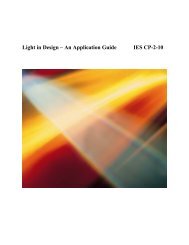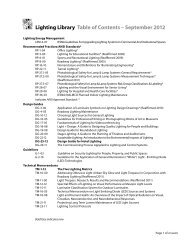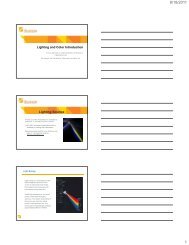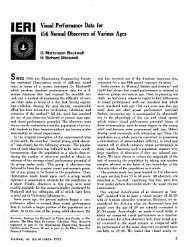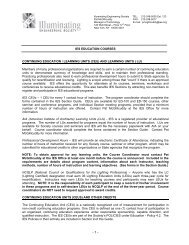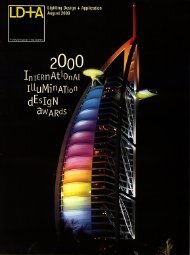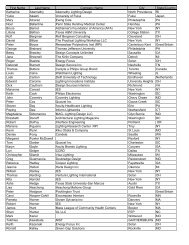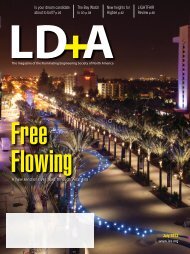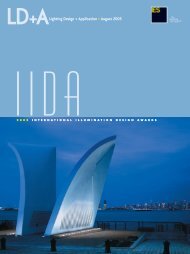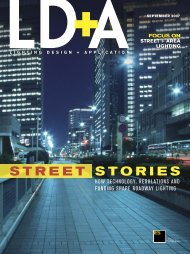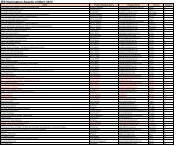Residential Lighting - Illuminating Engineering Society
Residential Lighting - Illuminating Engineering Society
Residential Lighting - Illuminating Engineering Society
Create successful ePaper yourself
Turn your PDF publications into a flip-book with our unique Google optimized e-Paper software.
(left) Incandescent cove uplighting, decorative<br />
wall sconces and table lamps, and fiber optics<br />
illuminating the steps, combine to allow the client<br />
superior flexibility within a fixed environment.<br />
(below) The interior street scene was layered<br />
with a combination of decorative lanterns,<br />
downlights, and PAR36s that created the<br />
layered lighting effects.<br />
(opposite, left) The dramatic technique of grazing<br />
the regal stone columns was achieved with<br />
low voltage PAR36 fixtures set to enhance rather than<br />
flatten the texture and nuances of the stones.<br />
(opposite, left) Decorative lanterns, wall sconces<br />
and recessed track blocked out in concrete.<br />
The decorative elements have an incandescent<br />
candle-like glow; however, the sources for the stairs,<br />
interior street, and accent lighting are the<br />
track fixtures, which can be placed where needed,<br />
giving the clients great flexibility.<br />
PEAKS OF LIGHT<br />
Robert Singer sets a mood, expanding and defining<br />
residential spaces with light<br />
You walk into a home and what do you see Any home, be it a 500<br />
sq ft studio apartment or a 40,000 sq ft mansion, will elicit comments<br />
about the view, the furniture, and the comfort of the surroundings.<br />
Ever wonder what the view or the furniture would be like<br />
with no thought put into the lighting design The dilemma of enhancing<br />
the appearance of a home is a challenge for a designer faced with the<br />
scale and scope of a premiere residence. With clients who own exclusive<br />
estates in the mountain enclaves of Aspen, the Roaring Fork Valley and<br />
other prime locations throughout the world, Robert Singer and<br />
Associates first seeks to create drama. The award-winning designer<br />
works closely with all of the design team—architects, interior designers<br />
and clients—to create layers of light for each aspect and room of a home.<br />
As Singer states, “Our goal is to create a warm, glowing environment, as<br />
welcoming to the visitor as it is to the owner.”<br />
Perceived brightness is created by indirect sources that throw light onto<br />
ceiling planes and wall surfaces. Finishing touches include augmenting<br />
the lighting with accent and decorative elements.<br />
Buttermilk Residence<br />
Located on the slopes near Aspen, the Buttermilk house is a classic castle<br />
with state-of-the-art features. Designed by A. Horacio Ravazzani y<br />
Arquitectos Asociados, Uruguay, the interior and exterior of the house is<br />
constructed of exposed board form concrete augmented with stone, wood<br />
and plaster. Because of the nature of the construction, there was no room<br />
for error in locating the light sources.<br />
“The client required the lighting to be functional, flexible and have a<br />
warm candle-like glow. In order to achieve the clients’ requirements, we<br />
needed to create layers of light encompassing general, accent, task, and<br />
decorative lighting. A state of the art control system was used to marry all<br />
of these elements into preset portraits of lights or scenes for the client that<br />
36 LD+A/February 2003 www.iesna.org



